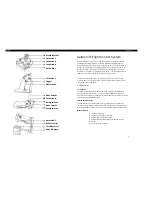
page 44
6.7. CANopen in the ecomat R 360
The CAN layers 1 and 2 described at the beginning of chapter 6
control the physical link and the transmission of the data
between the bus participants. For a practical CAN application
this means that the programmer is responsible for the definition
of the data protocol for the special application.
To obtain a uniform protocol layer for networking the different
participants which describes the meaning of the transmitted
data the CAN Application Layer (CAL) was determined as layer
7. CANopen is based on CAL and defines which data are to be
transmitted by which CAL services. The meaning of the data for
the corresponding device type (I/O module, drives, encoders,
etc.) is also defined. With these definitions the application
programmer can access all components with CANopen
capability independent of the manufacturer and without much
work on the protocol. CANopen participants which belong to the
same device family have organized their data the same way.
The characteristics of these device classes are indicated in the
"device profiles" (DS-40x).
Despite this definition the basic CAN structure which allows
each bus participant to send messages (data) to the network is
maintained. Only the network master (NMT master) exists once
and is mainly used for running up and monitoring the system.
The mechanisms described below are to give a rough overview
of the CANopen functions. If you wish to utilise the full CANopen
functions, please contact CAN in Automation Technical Centre.
General information on CANopen
In principle, each CANopen node has an object directory which
can be accessed via "Service Data Objects" (SDOs). In
addition, there are at least two "Process Data Objects" (PDOs)
for transmitting and receiving process data, a "Node Guarding
Object" to monitor the network as well as an "Emergency
Object" to indicate error states.
The object-oriented identifiers (11 bits) are called "CAN Object
Ids" (COB IDs) under CANopen. Via the 4 most significant bits
(MSBs) they are divided into 16 groups. The remaining 7 bits
are used to distinguish 127 CANopen nodes. This ensures a
clear assignment of the individual object types to the nodes.
This definition is a default assignment.
Summary of Contents for ecomat 100 R 360 Series
Page 1: ...System manual ecomat 100 type R 360 ...
Page 14: ...page 14 ...
Page 26: ...page 26 ...
Page 86: ...page 86 ...
Page 100: ...page 100 ...
Page 126: ...page 126 ...
Page 146: ...page 146 ...
Page 162: ...page 162 ...
Page 163: ...page 163 Annex 2 Wiring Annex 2 1 Type CR0015 ...
Page 164: ...page 164 Annex 2 2 Type CR0016 ...
Page 165: ...page 165 Annex 2 3 Type CR0017 ...
Page 166: ...page 166 Annex 2 4 Type CR0501 ...
















































